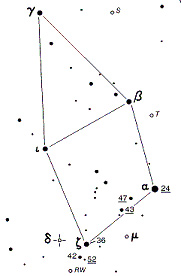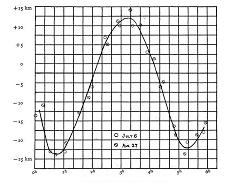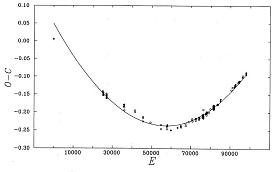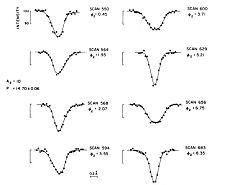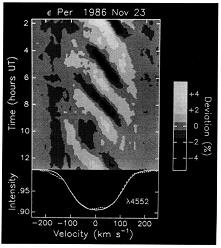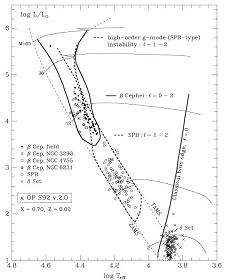Q. What class of variable star is most numerous among the very brightest stars?
A. The β Cephei stars
Q. What class of variable star is probably unfamiliar to most AAVSO observers?
A. The β Cephei stars
A Century Ago ....
|
In the early years of the 20th century, astronomical spectroscopy came of age. Through the work of careful, groundbreaking observers, it provided new information about stars, especially binary and variable stars. One example was the discovery, in 1902 by Edwin Frost, of the variability of the radial velocity of β Cephei. The radial velocity is the line-of-sight velocity, the velocity of approach or recession, and is measured by the Doppler effect. Frost initially surmised that β Cephei was a spectroscopic binary i.e. the radial velocity variations were due to orbital motion of the star. In fact, it was a pulsating star, in which the photosphere of the star alternately approaches and recedes from the observer. By 1906, Frost had determined a period of 0.19 day [rather short for a binary star!], and a complete radial velocity curve. In 1913, another pioneer observer, Paul Guthnick, discovered light variability in β Cephei with the same period. By 1938, in their landmark book Variable Stars, Cecilia Payne-Gaposchkin and Sergei Gaposchkin could list 17 probable members of the class though, in their table, they lumped them in with the δ Scuti stars.
Conspicuous Stars, Inconspicuous Variables
|
Beta Cephei variables are sometimes known as β Canis Majoris stars, for reasons which will be mentioned below. But, in the General Catalogue of Variable Stars, they are classified as BCEP (with the exception of three apparently shorter-period stars which, for some reason, are sub-classified as BCEPS). They have spectral types of B0-B2 III-V, corresponding to temperatures of 20-30,000 K, i.e. they are near the top of the main sequence on the Hertzsprung-Russell diagram. Their masses are typically 10-20 times that of the sun. They have periods of 0.1 to 0.3 days and, though their radial velocity amplitudes are quite large, their visual light amplitudes are very small, typically only a few hundredths of a magnitude. But that is deceptive. Satellite observations show that, in ultraviolet light, where most of the flux from these hot stars is found, their amplitudes are up to a magnitude. So if you had ultraviolet eyes, you would have no trouble measuring their variability by eye. But the small visual amplitude explains why the measurement of radial velocity variations was the observational method of choice. BW Vulpeculae, the largest-amplitude β Cephei star, has a vigorous pulsation amplitude of 200 km/s -- a velocity which is difficult to imagine! It's 20 times faster than a satellite in low-earth orbit!
|
A leading figure in β Cephei star research was Otto Struve (1897-1963). He and other spectroscopists studied these stars in detail. From long-term monitoring, they discovered that, in many of the stars, the pulsation amplitude was not constant, but varied slowly. This beat effect is now known to be due to the presence of two or more closely-spaced periods. While β Cephei does not show this effect, β Canis Majoris does; that is why some astronomers (especially in Europe) prefer the latter name to the official one. Spectroscopists also studied the level effect: they measured the radial velocity of absorption lines which arose in different levels of the star's atmosphere. In this way, they could observe how the pulsation wave rose upward though the atmosphere. They discovered unusual absorption line shapes and variations in some of the stars, which was later explained by the complex motions of their surfaces. They also discovered that many β Cephei stars were members of spectroscopic binary systems.
Watching Stars Evolve
Long-term monitoring also showed that the periods of many β Cephei stars varied slowly. This was what would be expected from the evolution of the star. As the star exhausted the thermonuclear fuel in its core, over its relatively short ten million year lifetime, it would slowly expand, then contract. So its period would first slowly increase, then decrease. The most striking example is BW Vulpeculae, the largest-amplitude β Cephei star. Its (O-C) diagram, which compares its actual period with the assumption of a constant period, shows that its period is increasing at +2.8 seconds per century. This represents the only way that astronomers can observe the slow, normal evolution of a star.
There are a large number of β Cephei stars among the brightest stars in the sky --- many α and β stars in their constellations. These were mostly discovered in the first half of the 20th century. Among the 20 brightest stars, they include β Cen (Hadar), β Cru (Mimosa), and α Vir (Spica) which apparently stopped pulsating about 1970. And α Eri (Achernar) is a pulsating Be star. Several astronomers [including me] carried out searches for new β Cephei stars in the 1960's and 1970's, but there were surprisingly few fainter variables discovered up to 1980. Starting about that time, there was much interest in the newly-discovered slowly-pulsating B stars, the 53 Persei stars, and pulsating Be stars, and less in the classical β Cephei stars. By 1993, however, Sterken and Jerzykiewicz (1993) were able to list 59 certain members, and 79 suspects. Also, a dozen β Cephei stars were discovered in southern clusters, and another dozen or so in northern clusters, bringing the total number to almost a hundred. As of 2004, the number listed in the General Catalogue is 85. There are also dozens of suspected variables. There is much work to be done.
Variables without a Cause
But no one could explain why the β Cephei stars pulsated. The cause of the pulsation of Cepheids and related stars had been discovered in the 1950's. It was due to the ionization and the opacity of hydrogen and helium in the outer layers of the stars. These two elements make up 98 per cent of the mass of the star. At the temperatures in the outer layers of Cepheids -- 7000K and up -- the hydrogen and helium undergo ionization; they lose their electrons. This results in opacity, the ability of the gas to absorb radiation. So when the pulsating star contracts, the hydrogen and helium absorb radiation and ionize. The radiant energy is stored as ionization energy. When the pulsating star expands, this energy is released, and helps to push the expansion outwards. It's like pushing a child on a playground swing: if you give them a push at the right time each cycle, then they will continue to swing, overcoming the effects of friction.
But β Cephei stars are much hotter than Cepheids, and well separated from them in the Hertzsprung-Russell diagram. Their hydrogen and helium are already ionized. Astronomers [including me] struggled to find a cause. At a conference in 1976, John Cox listed nine different possible pulsation mechanisms; a few others were suggested subsequently. None of them was successful. In the meantime, however, the mystery deepened: a whole new category of pulsating B stars was discovered -- non-radially pulsating B stars.
Undulators and other Relatives
|
Many years earlier, the beat effect in the β Cephei stars had been explained as the simultaneous presence of radial and non-radial pulsation modes with close periods. But it was only in the late 1970's that pure non-radially pulsating (nrp) B stars were discovered. This discovery came about in two ways. One was the detection of absorption line profile variations (lpv) in B stars, which was made possible by electronic -- first Reticon and then CCD -- detectors on astronomical spectrographs. Figure 5 shows the profile variations observed within a few hours in 53 Persei by Myron Smith and Marshall McCall; these authors published their results with the picturesque title of ``Undulations of a B-Type Star"; 53 Persei became the prototype of this sub-class of pulsating B stars.
|
ε Per is perhaps the most remarkable example of a non-radially pulsating star. This bright star exhibits absorption line profile variations which have been interpreted (Gies & Kullavanijaya 1988) in terms of non-radial pulsations with l = 3, 4, 5 and 6, with periods ranging from 2.3 to 4.5 hours. As with other non-radially pulsating stars, the brightness variations are very small --- only a few hundredths of a magnitude.
Another interesting sub-class of nrp B stars, discovered spectroscopically, is the ζ Ophiuchi stars. These have a series of ``moving bumps" which march through their absorption line profiles. The moving bumps are due to the presence of 10-20 non-radial pulsation waves, moving around the equator of the star. In astronomical jargon, this is called high-order non-radial pulsation. Epsilon Persei undergoes low-order non-radial pulsation.
The other methodology for discovering nrp B stars was careful photometric surveys which detected light variations in both the lpv B stars, and in a new class of photometric variables with periods of typically 1--2 days, which were called Slowly Pulsating B stars (SPB stars) or LBV in the GCVS --- an unfortunate term, since LBV usually refers to a ``luminous blue variable". The strategy for discovering β Cephei P stars photometrically had previously been to observe them for a few hours during the night, and look for the 3-6-hour variations. SPB stars vary only slightly in a few hours; observations over many hours must be carefully combined and analyzed, allowing for the ``alias" effects which would be found in the power spectrum due to the nightly gaps. The Hipparcos satellite photometry was useful in identifying and studying both SPB and β Cephei stars. SPB stars have since also been found in several clusters, and in the Large Magellanic Cloud.
Also about 1980, line profile variability and short-period photometric variability were discovered in several Be (γ Cas) stars; this variability had actually been discovered several decades earlier, but its significance was not recognized. Most astronomers [including me] now believe that this variability is due to nrp, though a few others believe that, in some or all cases, it is due to the rotation of the star. The theory of pulsation in rapidly-rotating stars is very complex, however, so this belief has not yet been tested fully by modelling.
With all these sub-classes of pulsating B stars, definition and classification became a problem. In the General Catalogue of Variable Stars β Cephei stars are defined according to their spectral type (O8-B6) and class (I-V), and the period (0.1-0.6 day), amplitude, and relative phases of their light, color, and velocity curve. I prefer to define β Cephei stars as early B stars which are pulsating in at least one radial mode. Other definitions have been suggested.
Stars "Pumping Iron"
So now there were a multitude of pulsating B stars, all of them ``variables without a cause". The breakthrough came in the 1980's when Norman Simon suggested that calculations of the opacity of the gas in stars -- especially the opacity of iron -- might have been underestimated at temperatures of 100,000-200,000K. Detailed recalculations of opacity by atomic physicists, starting in 1987, confirmed this suspicion. The opacity of iron atoms at these temperatures was sufficient to drive the observed pulsations --- and to solve other ``problems" in pulsation theory. The stars are, in a sense, ``pumping iron". Observation and theory now agree, with observation taking the lead.
|
The fact that the pulsation of Cephei stars depends on the presence of iron in its gases means that their incidence and variability may depend on whether they formed from metal-rich or metal-poor gas. There was some evidence that β Cephei stars were less common in the outer part of our Milky Way, where the stars had lower metal abundances. One test of this phenomenon would be to search for β Cephei stars in the Large and Small Magellanic Clouds, which have metal abundances of 0.01 and 0.005 as compared with 0.02 for stars like the sun. Initially, no β Cephei stars were found. Then three were found. Then the OGLE-II (Optical Gravitational Lensing Experiment, a Polish-led project) survey data were carefully reprocessed and, from photometry of over 75,000 early B-type stars, 64 probable β Cephei stars were found --- only one in a thousand, but not zero. These stars had some unusual properties. Their periods were almost twice as long as those of β Cephei stars in the Milky Way. That's partly because, when the metal abundance is low, β Cephei pulsational instability occurs only for cooler, larger stars. But it also appears that these stars may be undergoing low-order non-radial modes which are not observed in β Cephei stars in our galaxy. Or maybe they have not been looked for, carefully, in those stars.
A still-unsolved problem is what determines the amplitude of a β Cephei star. Whereas most Cepheids have comparable amplitudes, the amplitudes of β Cephei stars can be 0.3 or 0.03 or less. Careful comparison between observed stars, and theoretical models suggests two answers: stars which lie close to the center of the instability strip, and stars which rotate slowly, tend to have the largest amplitude. A similar problem holds for δ Scuti stars; the solution may be the same.
Making a CAT Scan of a Star
Now astronomers have begun an exciting new phase in the study of β Cephei stars and their relatives. As part of a larger project of ``asteroseismology" of B stars, Conny Aerts et al. (2004) gathered and analyzed a remarkable 21.2-year time series of 1493 high-quality multicolor Geneva photometric data on the B3V β Cephei star HD 129929. They found evidence for at least six periods, which they then used, in a subsequent paper, to do detailed seismic modelling of the star -- a veritable ``CAT scan" of the interior of a star. Space asteroseismology of β Cephei stars began somewhat accidentally in 1999, when the Wide Field Infrared Explorer (WIRE) satellite failed shortly after launch. But its star tracker was still usable. It was used for several high-precision photometric projects, including 5,000,000 observations over 17 days, of the β Cephei star β Crucis. At least three pulsation modes were detected, with millimag amplitudes. The Canadian MOST (Microvariability and Oscillations of STars) satellite, launched in 2003, and the French COROT satellite, to be launched later in this decade, will also supplement the ground-based data with ultra-high-precision photometry from space. This will provide a detailed new view of the structure and evolution of these once-mysterious stars.
|
Why is this relevant to AAVSO observers? It's not likely that you would want to observe β Cep itself, or any of the other bright members. The amplitudes are small, and it's difficult to find suitable comparison stars near bright variables. BW Vul is interesting to observe: it is the largest-amplitude β Cephei stars, and is not too bright, and is worth monitoring for its period change. The standard comparison and check stars for BW Vul (HD 199140) are: HD 198820 (HR 7996) and HD 198527, respectively; you can find out information about them on the SIMBAD website.
Also, if you are a CCD or PEP observer, then the β Cephei stars may account for a few of the slightly variable comparison stars that you have encountered. In fact, there are probably many undiscovered β Cephei stars in the magnitude 4-7 range. Or when you look at the more famous bright variable star in Cepheus (δ Cephei), you may want to reflect on its brighter but less-well-known neighbor. Or you may simply be interested in this story of the up-and-down history of the brightest class of variable stars in the sky.
- http://www.ster.kuleuven.ac.be/~peter/Bstars/ An on-line catalogue of pulsating B stars.
- Aerts, C. et al. 2004, "Asteroseismology of the β Cephei Star HD 129929: I. Observations, Oscillation Frequencies, and Stellar Parameters", Astron. Astrophys., 415, 241. [CAT-scanning a B star.]
- De Cat, P. 2002, "An Observational Overview of Pulsations in β Cephei Stars and Slowly Pulsating B Stars", in Radial and Non-Radial Pulsation as Probes of Stellar Physics, (eds. Conny Aerts, Timothy R. Bedding, and Jørgen Christensen-Dalsgaard), ASP: San Francisco, 196. [An excellent recent review.]
- Frost, E.B. 1906, "The Period of Beta Cephei", Astrophys. J., 24, 259.
- [The radial velocity curve of β Cephei.]
- Gies, D.R. and Kullavanijaya, A. 1988, "The Line Profile Variations of Epsilon Persei: I. Evidence for Multimode Pulsation", Astrophys. J., 326, 813. [The most remarkable nrp B star.]
- Lesh, J.R. and Aizenman, M.L. 1978, "The Observational Status of the β Cephei Stars", Ann. Rev. Astr. Astrophys., 16, 215. [A dated but still very useful review.]
- Moskalik, P. and Dziembowski, W.A. 1992, "New Opacities and the Origin of the β Cephei Pulsation", Astron. Astrophys., 256, L5. [Discovery of the pulsation mechanism of the β Cephei stars.]
- Pamyatnykh, A. A. 1999, "Pulsational Instability Domains in the Upper Main Sequence", Acta Astronomica, 49, 119. [The theoretical and observational β Cephei and SPB instability strips on the Hertzsprung-Russell diagram.]
- Smith, M.A. and McCall, M.L. 1978, "Undulations of a B-Type Star: 53 Persei", Astrophys. J., 223, 221. [Discovery of lpv stars.]
- Sterken, C. 1993, ``On the Period History of the β Cephei Star BW Vulpeculae" Astron. Astrophys., 270, 259. [The (O-C) diagram of BW Vul.]
- Sterken, C. and Jerzykiewicz, M. 1993, "Beta Cephei Stars from a Photometric Point of View", Space Science Reviews, 62, 95. [A comprehensive review.]
This month's Variable Star of the Season was prepared by Dr. John Percy, University of Toronto, editor of the AAVSO Photoelectric Photometry Newsletter.


